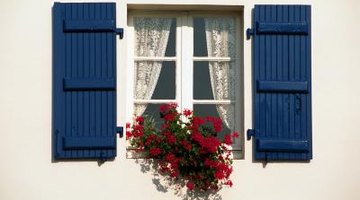Which Color Fades the Fastest on Exterior Shutters?
Exterior window shutters are an attractive and affordable addition to a home design. Window shutters are an eye-appealing way to increase your home's curb appeal. Sun exposure, wind and extreme weather conditions can cause exterior shutter paint to fade over time. Some exterior paint colors tend to fade faster than others.
Solid Black

The quality of your exterior paint, the direction your house faces and your paint preparation affect paint fading more than the paint color itself. However, some colors tend to fade more quickly than others. Solid black is a common shutter color that shows wear and tear if a fresh coat of paint is not applied every few years. Even though black is a dark neutral color, sun exposure causes solid black shutters to fade to charcoal and eventually to gray. Some black shutters fade to a murky brown hue.
Brown, Blue and Green
Chocolate brown, royal blue and hunter green tend to fade faster than lighter paint colors. These window shutter colors are not quite as intense as solid black, but their saturated color is deeply pigmented. As a result, the pigment lightens when it is exposed to harsh winds, frequent rain and sun. As opposed to black, these colors do stay true to their original hue. For example, the color may lighten and fade over time, but a royal blue shutter still looks blue even after it has faded.
Bright Red
Bright red exterior shutters are vivid and eye-catching, but their color tends to fade rapidly. If you opt for red shutters, applying a fresh coat of paint every 1 to 2 years may be necessary. Severely faded red shutters often appear pinkish or peach-colored and can clash with a home's overall exterior color. Red shutters range from firetruck red to maroon, so imagine what the paint will look like one shade lighter, and then choose the color accordingly.
Natural Wood
Wood-stained shutters look warm, cozy and authentic, but they do not hold up well in adverse weather conditions. If you opt for wooden shutters, you must apply a protective sealant once your freshly stained shutters have dried. Even protected wood-stained shutters fade over time, but a sealant will increase the stain's longevity. Choose a light-colored stain or a paint like pine or oak to decrease signs of fading.
References
Resources
Writer Bio
As curriculum developer and educator, Kristine Tucker has enjoyed the plethora of English assignments she's read (and graded!) over the years. Her experiences as vice-president of an energy consulting firm have given her the opportunity to explore business writing and HR. Tucker has a BA and holds Ohio teaching credentials.
Photo Credits
- Goodshoot/Goodshoot/Getty Images
More Articles



